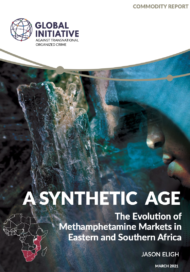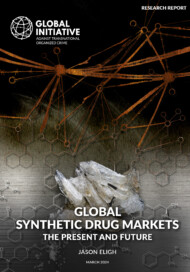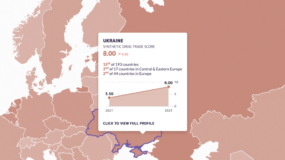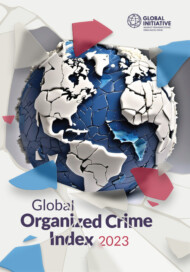Posted on 27 May 2025
In early 2025, a Europol-backed operation took down two of the world’s largest cybercrime forums. The platforms, Cracked and Nulled, had rapidly amassed over 10 million users, and facilitated criminal discussion, illicit trade and the sale of cybercrime services. Investigators estimated that they had generated around €1 million in profits. The incident underscores a critical trend identified in the latest Global Organized Crime Index: the criminal exploitation of online spaces, which is growing at ‘breakneck speed’.
The ubiquity of the internet has transformed black markets, with shadowy street transactions now taking place in sophisticated digital marketplaces. According to Europol’s 2025 Serious and Organised Crime Threat Assessment report, nearly all forms of serious and organized crime now have a digital footprint. Criminals are leveraging the online domain to increase efficiency and maintain anonymity, and darknet markets are generating US$5–7.5 million in daily revenue.
As of 2025, there are approximately 30 000 active websites on the dark web, 56–60% of which are involved in criminal activities. Darknet markets operate like legitimate websites, featuring product descriptions, images and vendor ratings, but use sophisticated encryption technology and cryptocurrencies to ensure anonymity. These platforms offer an unprecedented variety of illegal goods and services, including drugs, wildlife, counterfeit items, stolen data and hacking tools. Weapons trafficking is a particularly significant issue, accounting for over 35 000 listings in 2022, 60% of which were linked to the United States. Financial fraud accounts for over 34% of dark web activity, with the details of over 100 million compromised credit cards being leaked in 2022.
In addition, the surface web, including social media and e-commerce platforms, increasingly offers criminals – particularly in the illicit drug trade – a vast customer base, ease of use and a measure of anonymity. Wildlife trafficking is also becoming increasingly reliant on e-commerce, with Indonesia and China acting as major hubs for this trade.
Among the various illicit digital markets, the drug trade is one of the most prominent. In 2024, darknet marketplaces generated over US$1.7 billion in cryptocurrency-enabled drug transactions, marking year-on-year growth of over 20%. This trend corresponds with a systematic increase in the criminal market scores relating to illicit drugs in the latest Global Organized Crime Index. These scores measure the pervasiveness and impact of various illicit economies and activities, and in 2023 all drug market indicators worsened compared to the previous iteration of the Index. The global score for the heroin trade rose from 3.97 to 4.08, for cocaine from 4.52 to 4.82, for cannabis from 5.10 to 5.34 and for synthetic drugs from 4.62 to 4.95 out of 10. Indeed, between 2021 and 2023, every continent of the world experienced an average increase in drug scores for three out of the four drug markets the Index evaluates.
This consistent upward trend across regions highlights the expansion and entrenchment of illicit drug markets globally, and is likely to be due in part to developments in online distribution. Notably, the 2023 Index also reveals a ‘strong and statistically significant’ correlation between the synthetic drugs trade and cyber-dependent crimes. According to the Index, the online purchasing of synthetic drugs may suggest the existence of an established cyber environment, which implies a heightened risk of cyber-dependent criminality.
One of the most significant features of digital markets is that they facilitate the introduction of drugs to new areas, which in turn affects consumption patterns. By connecting with vendors worldwide, consumers can access drugs that were previously unavailable locally. For example, recent investigations have found that the synthetic psychedelic drug 2C-B has become more prevalent in rural areas of Scotland due to its availability on the dark web. Similarly, methamphetamine use has surged in rural American areas, with rates now surpassing those in urban areas, likely due in part to easier access through online platforms. Aggressive online marketing by sellers also boosts awareness of, and accessibility to, drugs in areas where exposure to them is limited offline or among consumers who may not have encountered these substances through traditional channels.
The shift to digital markets has also reshaped the way illicit substances are bought, sold and distributed. Online platforms, for example, encourage bulk purchasing, setting them apart from offline markets, where such transactions are difficult to coordinate and easier to detect. Darknet vendors are also becoming more sophisticated, with large sellers offering a wider range of products and focusing on high value transactions. Data from the United Nations Office on Drugs and Crime shows that while the number of marketplaces is decreasing, the average transaction size is rising, indicating growing wholesale activity. According to the study, most darknet sales in 2023 fell into the ‘large retail’ category (US$100–US$499), at 37.8%, followed by ‘potential wholesale’ purchases (over US$1 000) at 31.9%. ‘Small retail’ sales accounted for just 18.9%, with ‘social supply’ making up the remaining 11.4%.
The shift to digital trade was accelerated by the COVID-19 pandemic, as lockdowns pushed many consumers and vendors towards online platforms. As these transactions are more insular and anonymous than in-person trade, it is more difficult to track user behaviour. However, new local patterns have emerged, along with unique risks that are less common in offline markets, such as exposure to cyber fraud or health concerns caused by the use of unregulated substances by unpractised users. Despite these risks, digital drug markets are often seen as a safer alternative to street dealing, attracting new users who might have avoided traditional markets due to fear of violence or law enforcement.
The main drug sold online is cannabis, followed by synthetic drugs, cocaine and, to a lesser extent, opioids. However, the extent to which each drug relies on digital markets varies. Synthetic drugs show a higher proportion of sales on the darknet and in online shops than other drugs, while cannabis and cocaine are more likely to be obtained through social media, largely because of their partial legality and social acceptability. Heroin and other opioids do not have a significant presence online, as their sale is highly regulated and controlled. A user’s choice of platform thus usually depends on the type of drug sought. It is also reliant on the level of internet access in different regions.
Despite their ubiquity, online drug markets have distinct geographical hubs, shaped by regional roles in the global trade. Most dark web drug shipments originate from the US and Northern and Western Europe, as well as Russia. According to a recent report by the Global Initiative Against Transnational Organized Crime, a pioneering drug trade model has emerged in Russia, replacing traditional face-to-face exchanges with anonymous transactions on darknet markets using cryptocurrency and physical ‘dead drops’. Russia also recorded the highest proportion (85.7%) of drug users purchasing on the darknet in 2022, and a drug trafficking average of 5.75 in the 2023 Global Organized Crime Index.
North America, Northern Europe and Western Europe are also major consumer hubs. According to the latest Index, North America’s average drug trade score rose by 0.13 points, while the scores for Northern Europe and Western Europe increased by 0.31 and 0.27, respectively. Emerging markets in Asia and Latin America, such as China, Vietnam and Venezuela, are also becoming more involved in drug purchasing and, to some extent, manufacturing.
Digital drug marketplaces demonstrate remarkable resilience in the face of legal action. When sites are shut down, vendors and purchasers simply switch to another platform, ensuring that trade remains relatively uninterrupted. To combat online drug trafficking, states are introducing new laws, enforcement measures and digital reforms. However, to counter such a rapidly growing threat, countries will need to enhance intelligence gathering and harness emerging technology.
It is also crucial not to view the online drug trade in isolation. As a criminal market, it is deeply intertwined with a wide range of criminal activities, including cyber-dependent and financial crimes. As these illicit economies continue to flourish, tackling and dismantling the criminal networks involved will require more than technological advancements. The issue calls for international cooperation, policy adjustments and a deeper understanding of the constantly evolving cyber landscape.
This analysis is part of the GI-TOC’s series of articles delving into the results of the Global Organized Crime Index. The series explores the Index’s findings and their effects on policymaking, anti-organized crime measures and analyses from a thematic or regional perspective.



